PV column
consulting
2025/10/10
“The Electrotech Revolution” by Ember
In this column, we will introduce “The Electrotech Revolution,” by Ember in the UK on September 16, 2025.
Ember Energy Research (EMBER):
Ember Energy Research (EMBER), a UK-based energy think tank, takes an evidence-based, solutions-oriented approach to building an energy system that benefits everyone (driving the transition to clean energy).
Highlights
- 3x: Electrotech is around three times more efficient than fossil fuels
- -20%: Electrotech costs fall by around 20% every time deployment doubles
- -70%: Electrotech can displace 70% of fossil imports
About
The annual slidedeck from Ember Futures draws on wide-ranging evidence, including datasets from Ember and the International Energy Agency, extrapolating into the near future to paint a picture of the rapid transformation underway in the global energy sector.
The analysis looks at the energy system from a variety of different angles. It divides the energy system into two main parts – electricity generation and energy use. The world is split into four key groups – mature economies, China, emerging markets and petroregions. The analysis considers marginal change as well as system size, considering three key drivers of change – supply from renewables, demand from electrification and new technologies to connect the two.

Ember Energy Research: https://ember-energy.org/
The Electrotech Revolution (Web): https://ember-energy.org/latest-insights/the-electrotech-revolution/
The full slidedeck for The Electrotech Revolution (112 pages, PDF, English version) can be downloaded from this link.
https://ember-energy.org/app/uploads/2025/09/Slidedeck-The-Electrotech-Revolution-PDF.pdf
Next, we would like to introduce the executive summary of “The Electrotech Revolution.”
**********
Executive summary
A technology revolution in energy
The electrotech revolution is the most profound transformation of the energy system since the shift from biomass to fossil fuels in the 18th century. As electrotech costs fall and exponential growth continues, a century of evolution is converging into a decade of revolution.
Three groups of technologies are coming together to form electrotech – a revolution in the way the world generates, uses and shifts electrons – renewable supply from solar and wind; electricity demand from electric vehicles (EVs) and heat pumps; and connections from batteries and digitalisation.
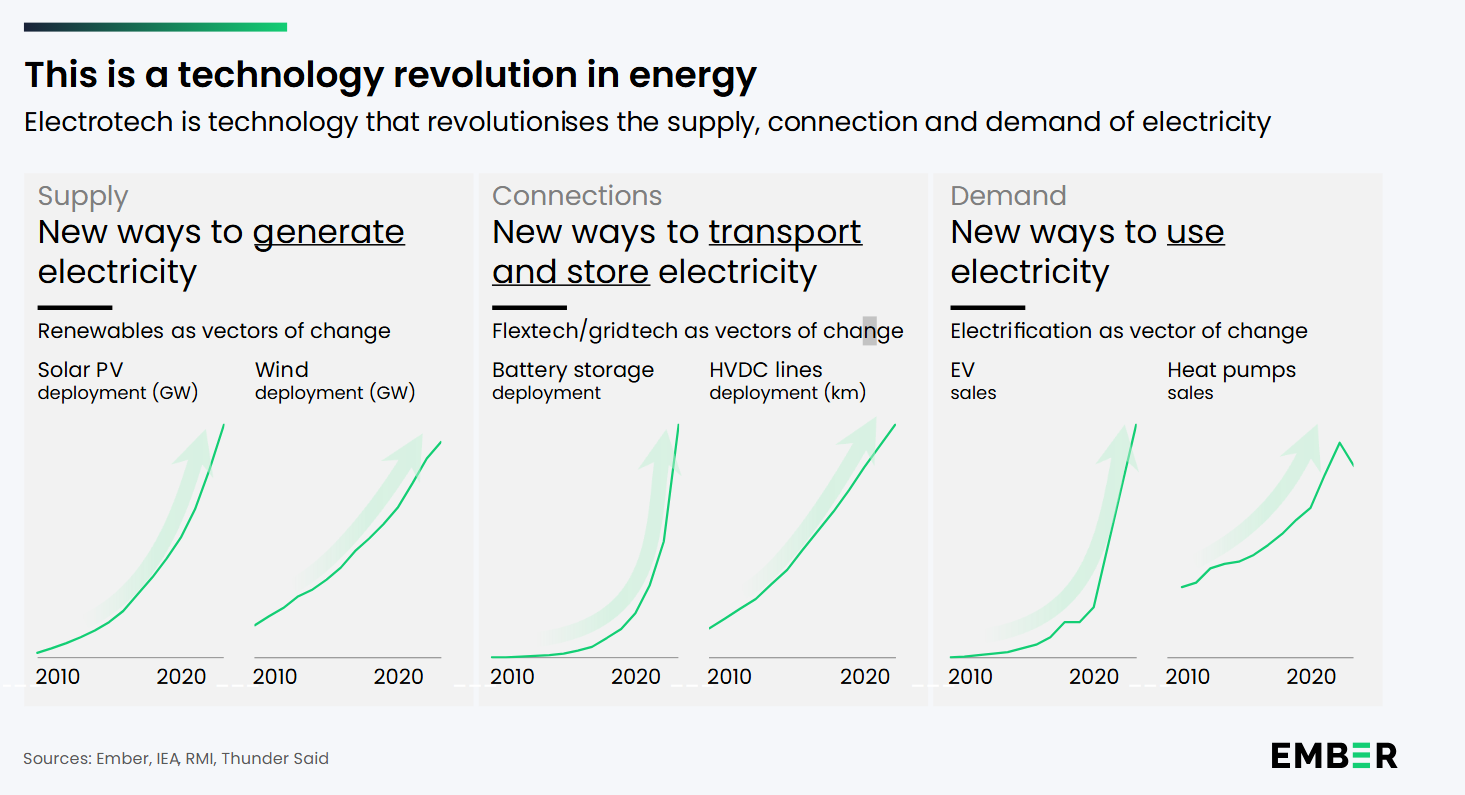
Electricity is now the engine of change, powered by rapidly scaling renewables and driving economy-wide efficiency gains through electrification. It offers a path to energy security for much of the world. As a result, fossil fuel demand is peaking sector by sector, country by country. The ceiling of what is possible – cheap, abundant, universal electricity – is far higher than we once imagined.
Three fundamental drivers of change
The arc of energy history bends towards solutions that are leaner, cheaper and more secure.
1. Physics: Electrotech makes the energy system more efficient
Electrotech is around three times more efficient than fossil fuel systems, which waste two-thirds of primary energy inputs (380 exajoules) as heat at a cost of $5 trillion every year. Solar and electrification enable us to harness the power of the sun, which gives access to 100 times as much energy as fossil fuels.
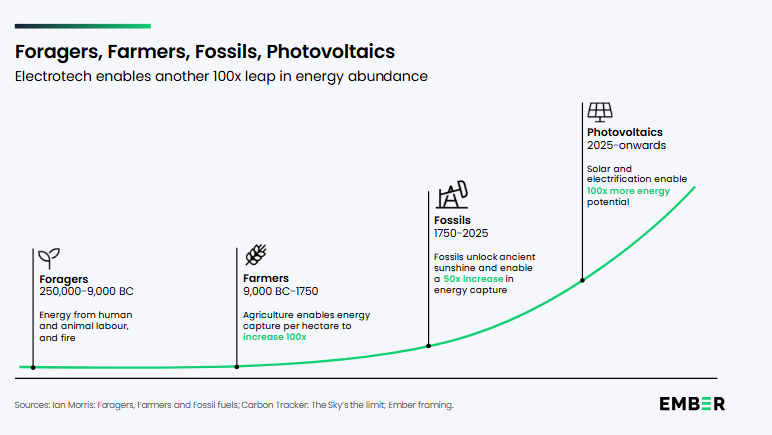
2. Economics: Electrotech gets cheaper as it scales
Fossil fuel commodities get more expensive as extraction continues, and their prices are elevated by major producers controlling the supply. Electrotech is manufactured and modular, resulting in clear technology learning curves, with costs falling by around 20% every time deployment doubles. Electrotech is already capturing two-thirds of global energy investment and is responsible for all the expected growth in energy jobs. Electrotech contributed 10% of global GDP growth in 2023, including 22% in China, 5% in India, 30% in the EU and 7% in the US.
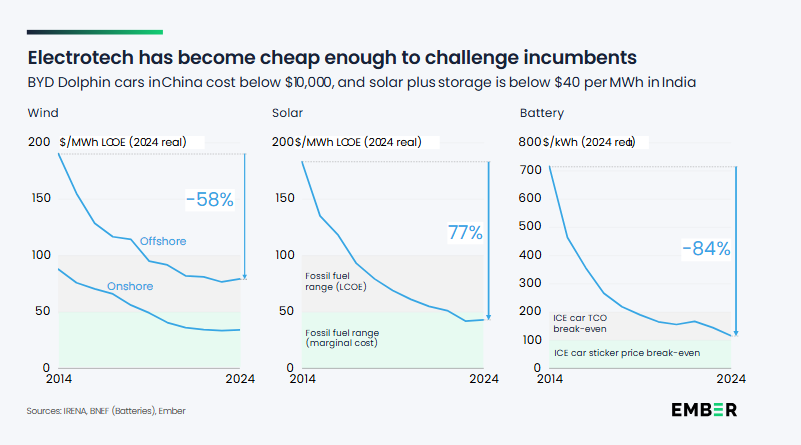
3. Geopolitics: Electrotech enhances independence and security
80% of the world lives in fossil fuel importing countries, with over 50 countries importing more than half their primary energy as fossil fuels. In contrast, 92% of countries have renewables potential over ten times their current demand. Replacing imported fossil fuels using three key levers—EVs, heat pumps and renewables—can cut net fossil fuel imports by 70%, saving $1.3 trillion globally each year. Once electrotech is bought, it lasts for decades, providing insulation from the vagaries of global pricing. When fossil flows stop, the economy stops. When electrotech flows stop, only growth is at risk.
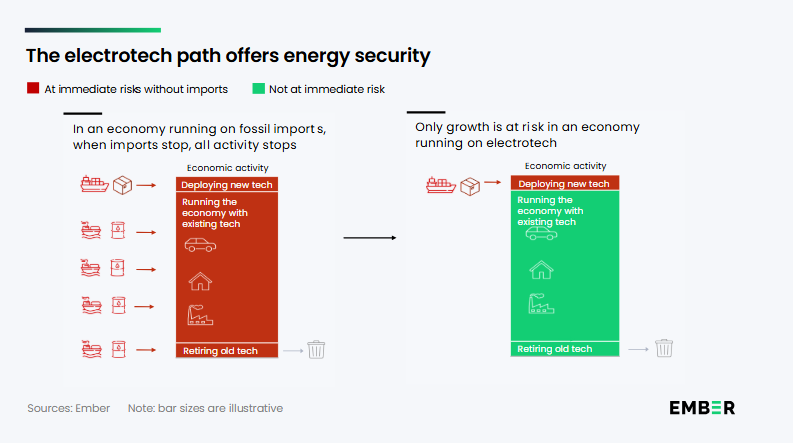
A century of evolution turns into a decade of revolution
Electrotech has grown exponentially for decades. Now it is too cheap to contain and too big to ignore.
01 Electrotech is already the main driver of energy growth
Exponential growth in electrotech is already reshaping energy markets. For 30 years, solar capacity has been doubling every three years on average, and since 2020, battery storage has been nearly doubling every year. Solar has gone from among the smallest to the largest source of capacity in a decade. Solar and wind dominate the growth in electricity demand. Electricity now supplies almost all the growth in final energy demand in buildings, industry and road transport. It overtook oil as the largest supplier of useful energy in 2007. Internal combustion engine (ICE) vehicle sales have been falling since 2017, and in the same period, EV sales are up 15-fold to 17.5 million.
02 China, the world’s first electrostate, is the pivot nation
China’s pivot to electrotech has been central to the global shift, sparking an explosion in manufacturing, innovation and deployment. China’s domestic roll-out of electrotech is unparalleled: it accounts for half of global solar panel installations, 60% of EV sales and two-thirds of global growth in electricity demand since 2019. In the first half of 2025, Chinese fossil demand in electricity generation was down by 2%. This is highly significant because global fossil fuel demand excluding China has been flat since 2018, and China has driven all the net growth.
03 Emerging markets are leapfrogging to a better energy system
Led by China, emerging markets are deploying electrotech solutions at scale to leapfrog to a better energy system as the global sunbelt starts to reap the benefits of its high insolation levels. From Viet Nam to Mexico, South Africa to India, Brazil to Namibia, 63% of emerging market electricity demand has leapfrogged the US in terms of solar as a share of generation. Meanwhile, electrification technologies are cascading out of China and into Asia; the ASEAN region and Bangladesh have just leapfrogged the US in terms of the electrification of final energy demand.
04 Three-quarters of energy demand can be supplied by electrotech
The ceiling of the possible has never been higher, unlocking a potential tripling of electrotech deployment. Leading regions and nations already get more than half their electricity from solar and wind, and 70-80% penetration from solar and wind at a reasonable price is within our reach today. Technology innovation in electric transport and heat pumps has pushed the proportion of global final energy demand that can be electrified from 25% in 2000 to 75% in 2025. Further innovation is chipping away at the final 25% in shipping, aviation and high temperature heat.
05 Electrotech is set to push global fossil demand into terminal decline by 2030
As electrotech surges into one country and sector after the next, it drives replacement, not addition. Fossil demand has been flat for industrial energy since 2014, for buildings since 2018, for road transport since 2019, and may peak for electricity this year. Two-thirds of countries have already seen peak fossil demand in end-use sectors, and half the world has seen a peak in fossil fuels for electricity. China is the pivot nation in the global system, and fossil electricity demand in China is down 2% in the first half of 2025. If current trends continue in renewables deployment and electrification, fossil fuel demand will be in decline by 2030. That implies disruption for the fossil fuel sector and the rise of new electrotech winners.
Sector by sector, country by country, the electrotech era is taking shape
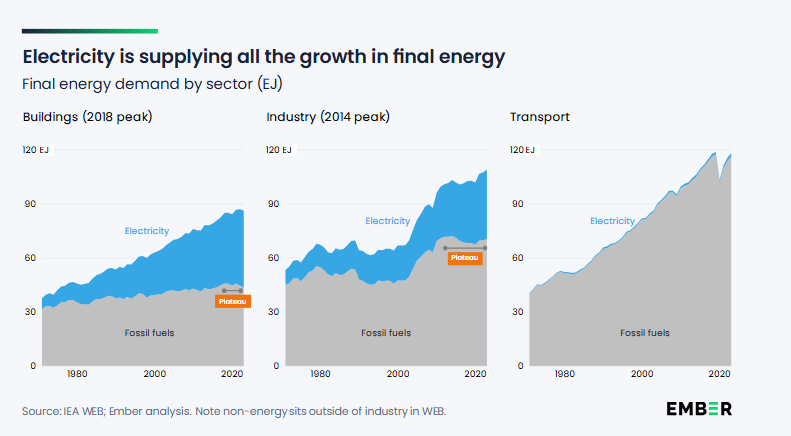
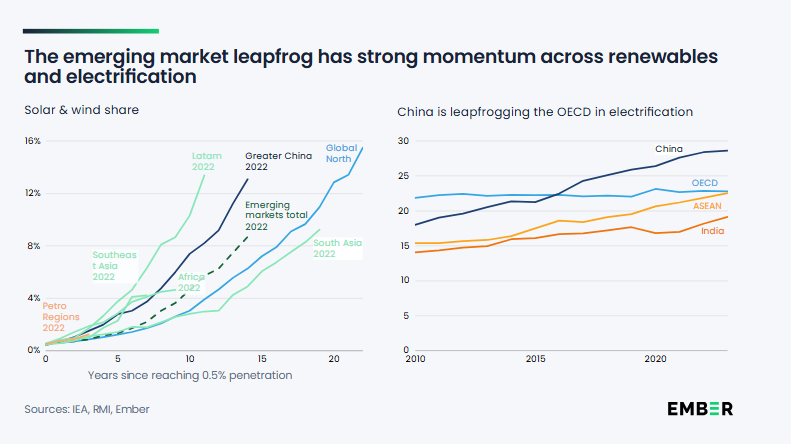
A new perspective – and an opportunity to seize
The concept of the electrotech revolution offers a new perspective on the energy debate. It better captures the reality of an energy system undergoing rapid technology disruption than the current two main perspectives on the future of energy, coming from the fossil gradualists and the net zero advocates.
At its core, this revolution is driven by physics, economics, and geopolitics. Short-term setbacks matter, but fundamentals matter more. And the fundamentals are stacked in electrotech’s favour.
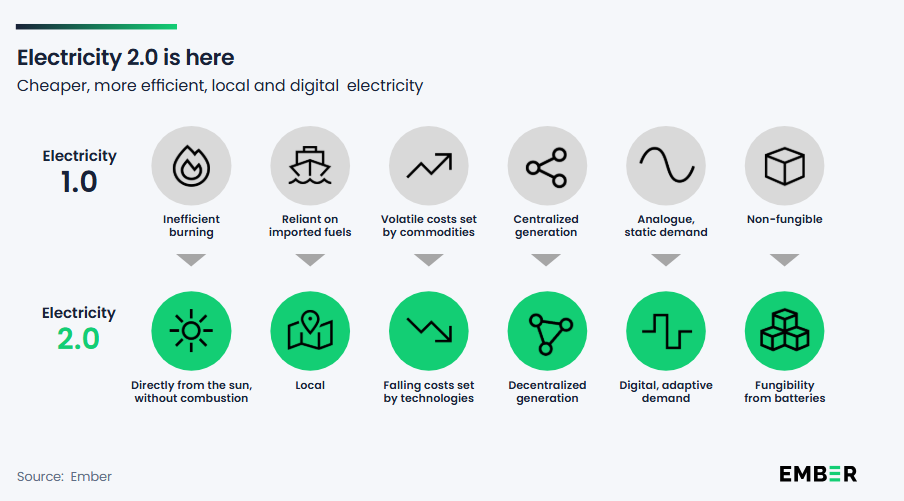
This is bigger than energy. As the marginal cost of electricity falls towards zero, energy abundance will unleash new waves of growth, industrial competitiveness, and digital innovation. Emerging markets stand to benefit most; petrostates face decline; and new electrostates will emerge.
Investors and companies need to pivot from ESG to embrace the electrotech revolution. Countries that want to reap the benefits of the electrotech revolution need to overcome fossil fuel resistance and get on with profound change. This means reducing the price of electricity, electrifying end uses and experimenting with policy solutions.
**********
Countries around the world are increasingly adopting renewable energy as a source of power generation, and electrification is progressing rapidly, coming in an era of new lifestyles and business models.
On the other hand, I feel that in Japan, there is a growing tendency to disregard facts (evidence) and the evaluation of various data, and to make judgments based on comfortable images and preconceived notions. Furthermore, since the bubble economy of the 1980s, Japan has experienced what has been called the “lost decade,” then the “lost 20 years,” then the “lost 30 years,” and is now approaching the “lost 40 years.” I feel that this is the result of interpreting low growth as a problem of economic phenomena or the government, and not looking at essential growth or the future.
Without being influenced by dualistic and superficial trends, we would like to contribute to creating models from Japan that will attract the world’s attention through renewable energy.
Acknowledgments: We would like to thank EMBER, U.K., for allowing us to reprint this informative article.

